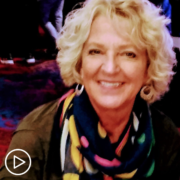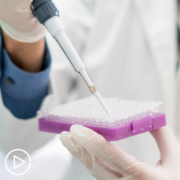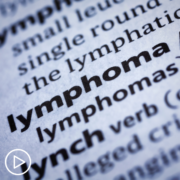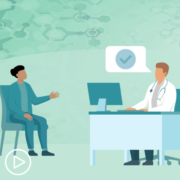What Are the Subtypes of DLBCL?
What Are the Subtypes of DLBCL? from Patient Empowerment Network on Vimeo.
What are the subtypes of diffuse large B-cell lymphoma (DLBCL)? Expert Dr. Robert Dean provides an overview of DLBCL subtypes and how treatments and outcomes can vary by a patient’s individual disease.
Dr. Robert Dean is a hematologist/medical oncologist at Taussig Cancer Institute at the Cleveland Clinic. Learn more about Dr. Dean, here.
See More From The Pro-Active DLBCL Patient Toolkit
Related Programs:
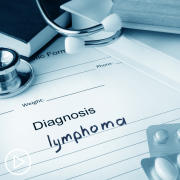
|

|
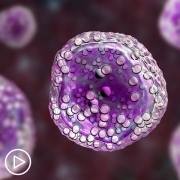
|
Transcript:
Katherine:
Dr. Dean, welcome. Would you please introduce yourself?
Dr. Dean:
Certainly, and thank you for having me. My name’s Rob Dean, and I’m a hematologist and medical oncologist and a staff physician at the Cleveland Clinic Taussig Cancer Institute.
Katherine:
Excellent. Thank you. Let’s start with looking at understanding and treating DLBCL. What are the subtypes of DLBCL?
Dr. Dean:
The classification of diffuse large B-cell lymphoma has gotten a little more complicated as our understanding of it has gotten deeper. Once upon a time going back maybe 15, 20 years an awful lot of cases were sort of lumped together under the broad label of diffuse large B-cell lymphoma and we always understood in the field that some patients did very well and were cured with the standard treatments of the time and that those treatments didn’t work as well for some patients.
And it’s taken years to get to a somewhat deeper understanding of what the underlying differences are in those cases that help to explain why our treatment outcomes differ for different patients, and I would say that’s feeding forward into trying to identify better treatment options for the patients who are in higher-risk groups. So, one way of understanding the heterogeneity in diffuse large B-cell lymphoma, the differences between cases, is to think about the way in which the normal cells of the immune system that turn into this kind of cancer develop. If you think about the old Time-Life Magazine illustration of the evolution of man where you see the series of figures drawn from left to right going from sort of more primitive, kind of a –
Katherine:
Ape-like.
Dr. Dean:
– ape-like figure to a progressively more modern-looking human standing upright and walking on just their legs. The way that these immune cells, which are the antibody-making B cells of the immune system, develop from a more primitive cell, you can think of it in similar terms. And we understand that cases of diffuse large B-cell lymphoma most commonly arise from a couple of points in that process of maturation that these cells are passing through as they go from the most primitive form that they take to their most mature functional form in the end.
So, one of those subgroups is something called the germinal-centered B-cell. And that involves the part of the maturation process where these immune cells have left the bone marrow, passed into a lymph node, and are interacting with other immune cells as part of their education and development process.
When the cells mutate at that stage of their development and turn into diffuse large B-cell lymphoma, the cure rate for patients with large cell lymphomas coming from that stage of immune cell development tends to be a little higher with standard treatments. When the lymphoma cells arise from an immune cell that has passed beyond that point in the maturation process to what is referred to as an activated B-cell, then the cure rates with standard treatment historically have been a little lower.
And so, you can look at markers on the lymphoma cells, or the activation of different genes in the lymphoma cells, to try to determine whether they came from an immune cell that was in one or the other of those points in its maturation process. And we know that that correlates with outcomes. So, that’s one of the main breakdowns that have become possible in understanding sort of what’s going on under the hood in diffuse large B-cell lymphoma and why do we see different outcomes in different patients.
Katherine:
Right.
Dr. Dean:
The other major change comes from understanding that for cases of large B-cell lymphoma there are common chromosomal changes that result in turning on specific genes. And if some of those genes are present in the right combination, that can create a much more rapidly growing and more chemotherapy-resistant form of large B-cell lymphoma. The two genes that are most commonly involved in that kind of a change are something called BCL-2 which, when it’s turned on abnormally, helps protect the lymphoma cells from being killed or being sort of triggered into dying by chemotherapy medicine.
And another gene that’s called MYC, or M-Y-C is how that’s spelled, and what that gene does is it tends to cause the cells to proliferate more rapidly.
It turns on other pro-survival figures and controls a pretty broad range of different programs that drive the cells to grow more quickly. So, when you’ve got both of those changes at the same time that’s sometimes referred to as a “double-hit lymphoma.” And large cell lymphomas with that double-hit kind of chromosome change have been shown in studies to have a significantly lower cure rate with our most commonly used standard treatment for this form of lymphoma, what we call R-CHOP.
So, being able to recognize those changes in cases of large B-cell lymphoma is important nowadays, both in terms of being able to share prognostic information with patients, to be able to tell them what we think the likelihood of not just getting into remission but eventually being cured will be. And also, for some situations, considering whether a treatment other than the standard R-CHOP regimen might be a better option.


